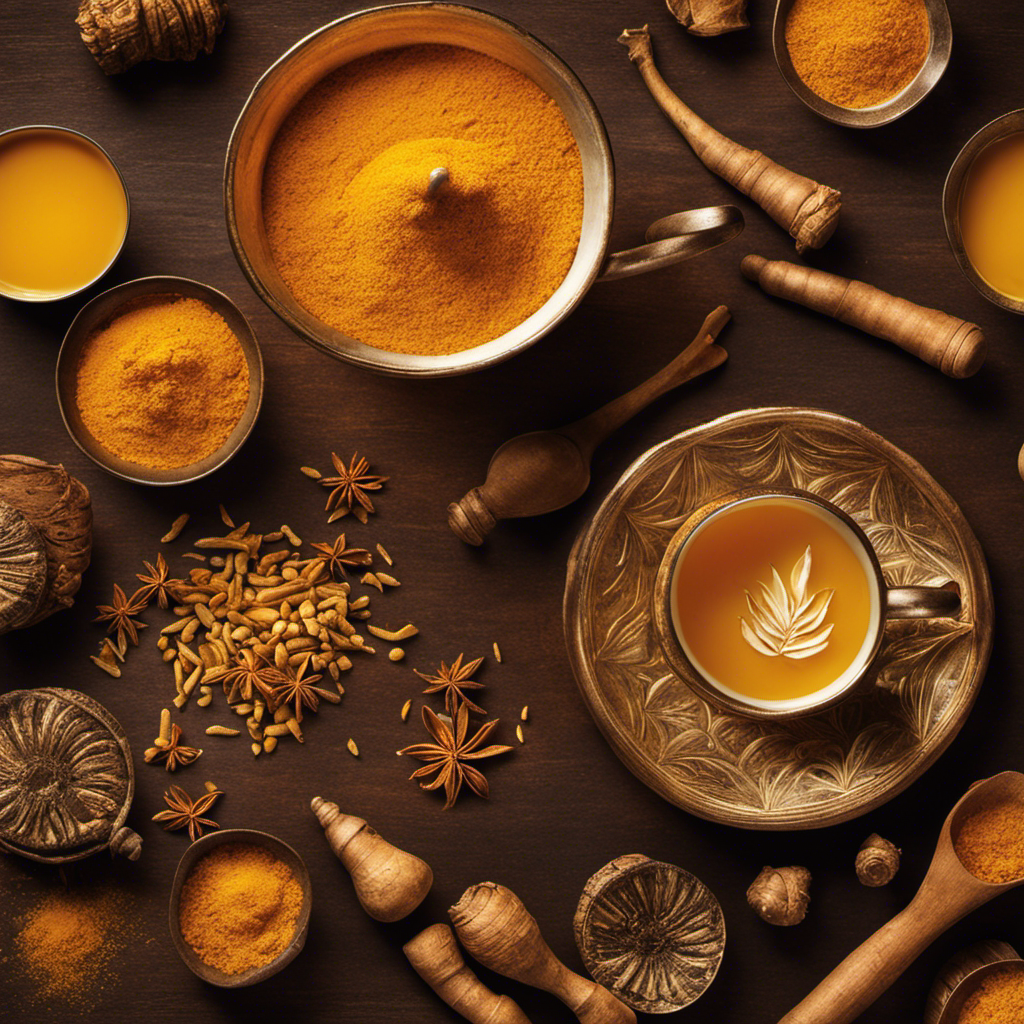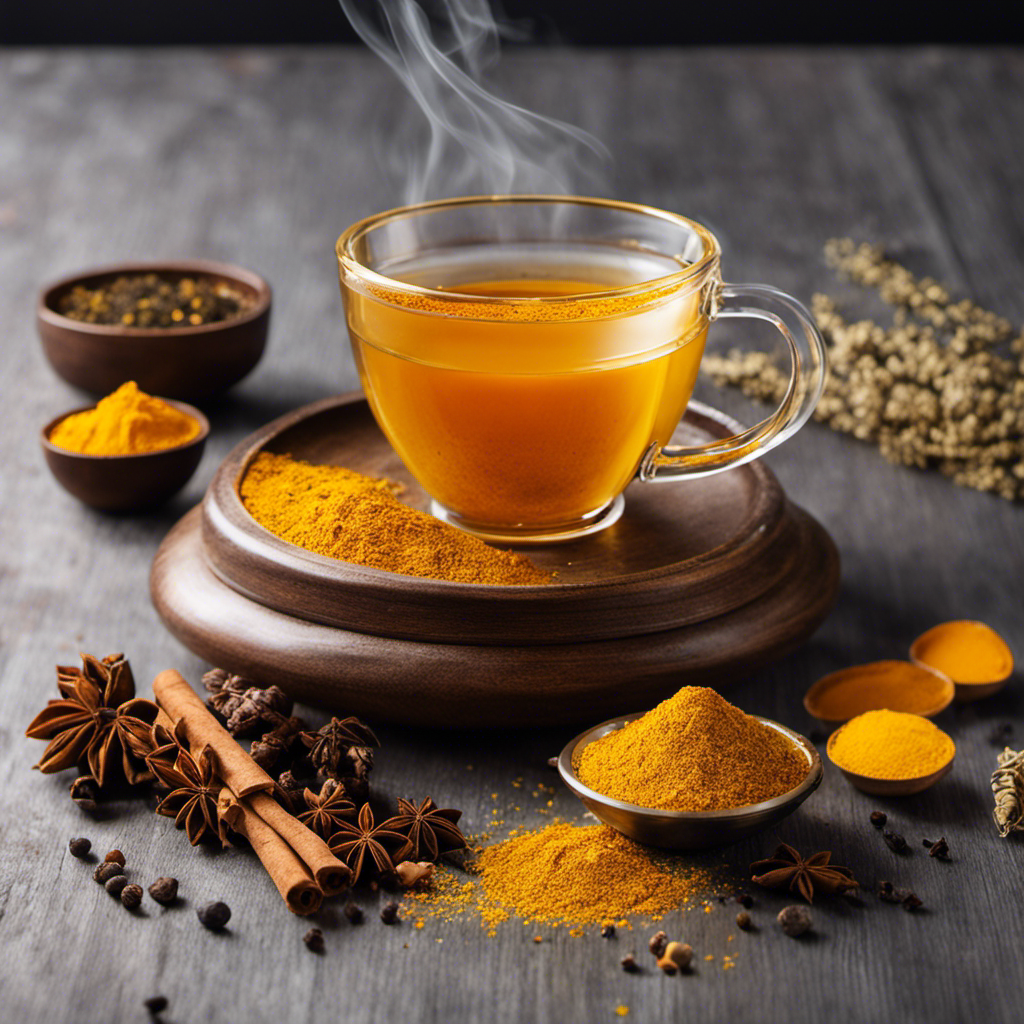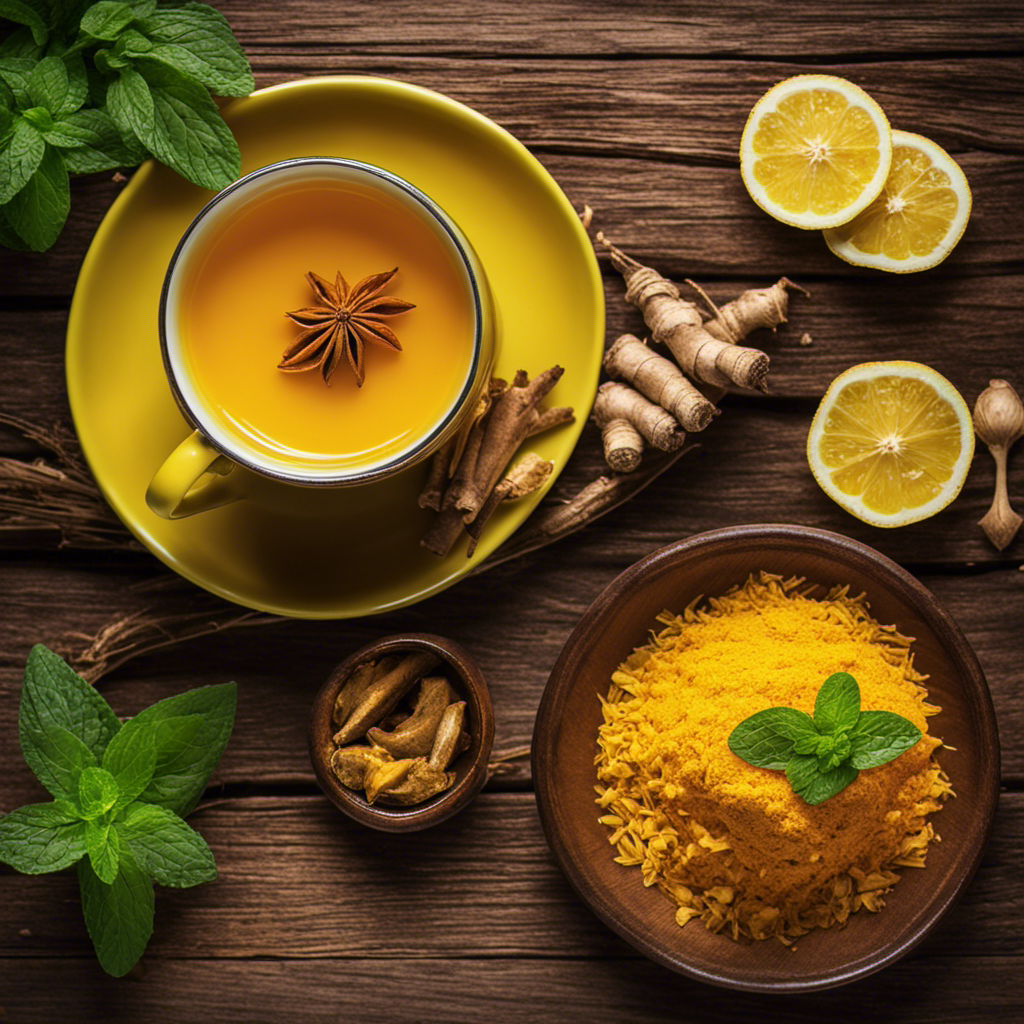Turmeric Tea
Turmeric Tea Using a Powder

If you’re seeking a natural method to improve your health, turmeric tea is the solution. Due to its powerful anti-inflammatory properties and array of health benefits, this golden beverage has gained popularity among many.
In this article, we’ll show you how to make turmeric tea using a powder. You’ll learn about the health benefits, how to choose the right turmeric powder, and a step-by-step guide to brewing the perfect cup.
So grab your favorite mug and get ready to savor the goodness of turmeric tea.
Key Takeaways
- Turmeric tea has potent anti-inflammatory properties.
- Turmeric tea may aid in weight loss by increasing metabolism and promoting fat burning.
- Turmeric tea can help reduce chronic inflammation, which is linked to various health conditions.
- Choosing the right turmeric powder, such as organic or non-GMO options with a high curcumin content, ensures maximum health benefits.
Health Benefits of Turmeric Tea
You’ll be amazed by the health benefits of turmeric tea. This golden drink has been used for centuries in traditional medicine for its numerous healing properties.
One of the benefits of turmeric tea is its potential role in weight loss. Studies have shown that the active compound in turmeric, called curcumin, can help increase metabolism and aid in fat burning.
Additionally, turmeric tea has anti-inflammatory properties that can help reduce inflammation in the body. Chronic inflammation has been linked to various health conditions, such as heart disease, diabetes, and arthritis.
How to Choose the Right Turmeric Powder
When choosing the right turmeric powder, it’s important to consider factors like quality and source. Quality turmeric powder can provide more health benefits and a better flavor to your turmeric tea. To find quality turmeric powder, look for the following characteristics:
| Characteristics | Description |
|---|---|
| Bright yellow color | Indicates freshness and high curcumin content, which is the main active compound in turmeric |
| Organic or non-GMO | Ensures that the powder is free from harmful pesticides and genetically modified organisms |
| High curcumin content | Curcumin is responsible for many of turmeric’s health benefits, so look for powders with a high percentage |
| Fresh and aromatic smell | Indicates that the turmeric powder is of good quality and has not been sitting on the shelf for too long |
| Reputable source | Choose powders from established brands or trusted suppliers to ensure the highest quality and purity |
Step-by-Step Guide to Making Turmeric Tea
To make turmeric tea, all you need is some boiling water, a pinch of black pepper, a squeeze of lemon, a dash of honey, and a sprinkle of cinnamon. It’s a simple and delicious way to enjoy the health benefits of turmeric.
Here’s a step-by-step guide to help you make the perfect cup of turmeric tea:
- Start by boiling a cup of water.
- Once the water is boiling, add a teaspoon of turmeric powder.
- Add a pinch of black pepper to enhance the absorption of turmeric’s key compound, curcumin.
- Squeeze in some fresh lemon juice for added flavor and vitamin C.
- Finally, sweeten your tea with a dash of honey and sprinkle a pinch of cinnamon on top.
Enjoy your warm and comforting turmeric tea, packed with antioxidants and anti-inflammatory properties. Feel free to experiment with alternative turmeric beverages or try different spices to create unique variations of turmeric tea.
Tips for Enhancing the Flavor of Turmeric Tea
If you want to enhance the flavor of your turmeric tea, try adding a pinch of ginger for a spicy kick. Ginger and turmeric are both popular spices known for their health benefits, and when combined, they create a delicious and warming beverage.
When brewing turmeric tea, it is important to use high-quality turmeric powder and fresh ginger for the best taste. To make the tea, simply add a teaspoon of turmeric powder and a pinch of grated ginger to a cup of hot water. Let it steep for 5-10 minutes, then strain and enjoy.
The best time to drink turmeric tea is in the morning or before bed, as it can help boost digestion and promote relaxation. So why not try adding some ginger to your turmeric tea and enjoy its flavorful benefits today?
Turmeric Tea Recipes for Different Health Goals
Looking for ways to achieve different health goals? Try adding various ingredients to your turmeric tea recipe and enjoy the benefits!
Turmeric tea is not only a delicious and warming beverage, but it also offers numerous health benefits. Here are three ways you can customize your turmeric tea to target specific health goals:
-
Immune System Boost: Add a squeeze of lemon juice and a pinch of black pepper to your turmeric tea. Lemon juice is rich in vitamin C, which helps support a healthy immune system. Black pepper contains piperine, a compound that enhances the absorption of curcumin, the active ingredient in turmeric.
-
Weight Loss Benefits: Incorporate a teaspoon of honey and a dash of cinnamon into your turmeric tea. Honey provides natural sweetness without added sugars, while cinnamon has been shown to help regulate blood sugar levels and reduce cravings.
By experimenting with different ingredients, you can create a turmeric tea recipe that not only tastes great but also supports your specific health goals.
Cheers to a healthier you!
Frequently Asked Questions
Can I Use Fresh Turmeric Root Instead of Turmeric Powder to Make Turmeric Tea?
Yes, you can use fresh turmeric root instead of turmeric powder to make turmeric tea. Fresh turmeric root has the same benefits for inflammation as turmeric powder, and it adds a vibrant flavor to your tea.
How Many Cups of Turmeric Tea Should I Consume Daily to Experience Its Health Benefits?
To experience the health benefits of turmeric tea, you should consume 1-2 cups daily. However, it’s important to note that excessive consumption may lead to potential side effects. Consult a healthcare professional for personalized advice.
Can I Add Other Spices or Herbs to My Turmeric Tea for Added Flavor and Health Benefits?
To enhance the flavor and health benefits of your turmeric tea, you can spice it up with other herbs and spices. This not only adds a level of sophistication but also boosts digestion and fights inflammation.
Is It Safe for Pregnant Women and Breastfeeding Mothers to Consume Turmeric Tea?
During pregnancy, it is important to consider the safety of consuming turmeric tea. While it is generally safe, it’s best to consult with your healthcare provider to address any concerns about pregnancy safety and breastfeeding.
Can Turmeric Tea Help With Weight Loss, and if So, How Should I Incorporate It Into My Weight Loss Routine?
Turmeric tea can potentially aid in weight loss by boosting metabolism. To incorporate it into your routine, drink a cup daily alongside a balanced diet and exercise. Remember, consistency is key for effective results.
Conclusion
In conclusion, turmeric tea made with powder is a delicious and healthy beverage that offers numerous health benefits. By choosing the right turmeric powder, you can ensure you’re getting the highest quality and most potent form of this golden spice.
Follow the step-by-step guide to make your own turmeric tea at home, and don’t be afraid to experiment with different flavors and ingredients to enhance the taste.
Whether you’re looking to boost your immune system, reduce inflammation, or simply enjoy a soothing beverage, turmeric tea is a fantastic choice. So grab your mug and start sipping your way to better health!
Arf, an author and an innovative enthusiast of coffee, coffee alternatives, and tea, plays a crucial role as a contributor to the esteemed Cappuccino Oracle platform. Renowned for his curiosity and passion for these captivating beverages, Arf has carved out a unique space for himself in the world of exploration and writing. He realized that coffee, coffee alternatives, and tea are not mere drinks to keep one awake, but universes of flavors and stories waiting to be explored.
Arf’s articles for Cappuccino Oracle blend meticulous research with personal experiences, providing readers with an in-depth understanding of various types of coffee, coffee alternatives, and tea, along with their unique characteristics, cultures, and histories. His honest reviews and engaging narratives guide readers on their own journeys, helping them discover their preferences and find their perfect brew.
Turmeric Tea
How Much Turmeric to Use for a Cup of Tea

Are you fed up with trying to figure out how much turmeric to put in your tea? Don’t worry any longer! This article will solve the mystery for you and give you science-backed tips on finding the perfect turmeric-to-water ratio.
Whether you’re a turmeric enthusiast or simply curious about its health benefits, we’ve got you covered. So, grab your favorite mug and get ready to unlock the full potential of turmeric in your tea.
Let’s dive in!
Key Takeaways
- Experiment with different amounts of turmeric to find the perfect ratio for your cup of tea.
- Consider personal taste preferences and desired health benefits when determining the turmeric-to-water ratio.
- Increasing the amount of turmeric can enhance its medicinal properties, but start with a small amount and gradually increase to avoid overwhelming other flavors.
- Consuming turmeric with black pepper enhances the absorption of curcumin, so it is recommended to add black pepper to your turmeric tea.
Understanding the Benefits of Turmeric in Tea
Turmeric has numerous health benefits when added to tea. It can reduce inflammation and boost the immune system. Understanding turmeric’s bioavailability is key to maximizing its benefits. The active compound in turmeric, curcumin, has low bioavailability on its own. However, when consumed with black pepper or fat, the bioavailability of curcumin increases significantly.
Black pepper contains piperine, a compound that enhances the absorption of curcumin. Additionally, curcumin is fat-soluble. Consuming turmeric with a source of fat, such as coconut milk, can also enhance its absorption.
Turmeric has been used in traditional medicine for centuries, particularly in Ayurvedic practices. It has been valued for its anti-inflammatory, antioxidant, and antimicrobial properties.
Incorporating turmeric into your tea can be a simple and effective way to harness its health benefits.
Determining the Ideal Turmeric-to-Water Ratio
To find the perfect ratio, it’s important to experiment with different amounts of turmeric when making a cup of tea. The ideal turmeric to water ratio varies depending on personal taste preferences and desired health benefits.
Here are three factors to consider when determining the ideal turmeric measurements:
-
Flavor Intensity: Adjusting the amount of turmeric will impact the taste of your tea. Start with a small amount and gradually increase it until you achieve the desired flavor.
-
Health Benefits: Turmeric contains a compound called curcumin, which has numerous health benefits. Increasing the amount of turmeric in your tea can enhance its medicinal properties.
-
Color: Turmeric gives tea a vibrant golden hue. If you prefer a deeper color, you may need to add more turmeric to your brew.
Exploring Different Methods of Incorporating Turmeric in Tea
When exploring different methods of incorporating turmeric in tea, it’s important to consider alternative ingredients for added flavor.
Turmeric tea can be enjoyed on its own, but if you want to enhance the taste, there are various options to consider.
One alternative recipe is to add ginger and honey to your turmeric tea. Ginger adds a spicy kick while honey provides a touch of sweetness.
Another option is to mix turmeric with other herbal teas like chamomile or green tea. This can create a unique flavor profile and provide additional health benefits.
However, it’s important to note that while turmeric tea is generally safe, it may have potential side effects for some individuals. These can include digestive issues, allergic reactions, or interactions with certain medications.
It’s always best to consult with a healthcare professional before incorporating turmeric tea into your routine.
Adjusting Turmeric Amounts for Personal Taste Preferences
If you prefer a stronger flavor, you can increase the amount of turmeric in your tea. Adjusting the amount of turmeric in your tea is a great way to find the right balance and create a flavor profile that suits your personal taste preferences.
Here are three things to consider when adjusting the flavor of your turmeric tea:
-
Start with a small amount: If you’re new to turmeric tea, start with a small amount of turmeric and gradually increase it until you reach your desired flavor. This will help you avoid overwhelming the other flavors in the tea.
-
Experiment with ratios: Turmeric can have a potent taste, so you may need to adjust the ratios of other ingredients in your tea to achieve the perfect balance. For example, if you find the turmeric flavor too strong, you can add more milk or honey to mellow it out.
-
Take note of potency: The potency of turmeric can vary from batch to batch, so keep that in mind when adjusting the amount you use. If you’re using a particularly potent batch, you may need to use less turmeric than you normally would.
Finding the right balance of turmeric in your tea is a personal journey. By adjusting the flavor to suit your taste preferences, you can enjoy a cup of turmeric tea that is both delicious and satisfying.
Expert Tips for Maximizing the Health Benefits of Turmeric Tea
One important tip for getting the most health benefits from turmeric tea is to ensure that you’re using fresh ingredients. Turmeric contains a compound called curcumin, which has numerous health benefits, including its anti-inflammatory and antioxidant properties. However, curcumin is not easily absorbed by the body. To maximize turmeric absorption, it is recommended to consume it with black pepper and a source of fat, such as coconut milk or ghee. Black pepper contains a compound called piperine, which enhances the absorption of curcumin. Additionally, consuming turmeric tea with a source of fat helps to increase its solubility and absorption in the body. As for the best time to drink turmeric tea, it is generally recommended to have it in the morning or evening, as it can help promote digestion and support overall health. Here’s a table summarizing these tips:
| Tip | Details |
|---|---|
| Use fresh ingredients | Fresh turmeric and black pepper are recommended for maximum health benefits. |
| Consume with a source of fat | Adding coconut milk or ghee can enhance the absorption of curcumin. |
| Drink in the morning or evening | Turmeric tea can support digestion and overall health when consumed at these times. |
Frequently Asked Questions
Can Turmeric Tea Help With Weight Loss?
Turmeric tea can potentially aid in weight loss. It may increase metabolism and help suppress appetite. Incorporating turmeric tea into your routine, along with a balanced diet and exercise, may support your weight loss goals.
Is It Safe to Consume Turmeric Tea During Pregnancy?
During pregnancy, it’s important to consult with your healthcare provider before consuming turmeric tea. While turmeric tea has many benefits, it may have potential risks and could interact with certain medications.
Can Turmeric Tea Interact With Certain Medications?
When it comes to certain medications, turmeric tea might have an effect. It’s important to consider the potential interactions between turmeric tea and your medications to ensure your safety and wellbeing.
Does Turmeric Tea Have Any Side Effects?
When making turmeric tea, it’s important to consider any potential side effects. While turmeric tea has numerous benefits, such as its anti-inflammatory properties, it can cause digestive issues or interact with certain medications. Be cautious and consult with a healthcare professional if needed.
How Long Should Turmeric Tea Be Steeped for Maximum Health Benefits?
To maximize the health benefits of turmeric tea, steep it for 10-15 minutes. This will allow the active compounds in turmeric, like curcumin, to fully infuse into the tea. Enjoy it at any time of day for best results.
Conclusion
In conclusion, harnessing the power of turmeric in your tea can be a transformative experience. Just like a drop of golden sunlight, turmeric illuminates the health benefits of this ancient spice.
By finding the perfect turmeric-to-water ratio and exploring different methods of incorporation, you can unlock a world of flavor and wellness. Remember, the key is to adjust the turmeric amounts to suit your taste preferences.
With expert tips in mind, you can maximize the potential health benefits of turmeric tea and embark on a journey to a healthier you. So go ahead, sip on that cup of golden goodness and let turmeric guide you towards a brighter future.
Noah, the Editor-in-Chief at Cappuccino Oracle, plays a pivotal role in shaping the voice and vision of our renowned platform. With an unwavering passion for coffee, coffee alternatives, and tea, Noah leads Cappuccino Oracle towards new horizons in the realm of coffee journalism.
Beyond his professional responsibilities, Noah serves as a mentor and guiding force for his team. His dedication to journalistic excellence and genuine love for coffee, coffee alternatives, and tea continue to inspire and motivate the Cappuccino Oracle family. In the ever-evolving world of these beverages, Noah’s leadership ensures that our platform remains at the forefront, delivering enlightening and enjoyable content to our readers worldwide.
Turmeric Tea
Turmeric Tea Do You Need to Peel

Do you enjoy sipping on a nice cup of turmeric tea to kick off your day?
Did you know that by peeling the turmeric before making your tea, you can enhance its health benefits even further?
In fact, studies have shown that the peel of turmeric contains higher concentrations of certain compounds that can support your overall well-being.
In this article, we will explore the benefits of turmeric tea, how to make it, and the health effects of using the peel.
Plus, we’ll share some handy tips for peeling turmeric to ensure you get the most out of your cup of tea.
Key Takeaways
- Turmeric tea boosts the immune system and reduces the risk of infections and illnesses.
- Turmeric peel contains curcumin with immune-boosting properties and may reduce pain and inflammation.
- Incorporating turmeric peel into the diet may provide health advantages, including potential benefits for arthritis and inflammatory bowel disease.
- Turmeric peel can be used in cooking, skincare products, and to enhance soups, sauces, and stir-fries.
Benefits of Turmeric Tea
If you’re looking for a natural way to boost your immune system, turmeric tea can provide you with numerous benefits.
Turmeric, a spice commonly used in Indian cuisine, contains a compound called curcumin, which has been shown to have powerful antioxidant and anti-inflammatory properties.
Drinking turmeric tea regularly can help support your immune system, reducing the risk of infections and illnesses.
Additionally, turmeric tea has been found to aid in digestion and promote a healthy gut.
To prepare turmeric tea, simply bring water to a boil, add a teaspoon of turmeric powder or grated fresh turmeric root, and let it simmer for 10 minutes.
You can also add a pinch of black pepper to enhance the absorption of curcumin.
Enjoy this warm and comforting beverage to reap the many benefits it offers.
How to Make Turmeric Tea
To make turmeric tea, simply grate or finely chop the turmeric root before adding it to boiling water.
Turmeric tea is a popular beverage known for its numerous health benefits. The recipe is quite simple, requiring only a few ingredients.
Start by peeling the turmeric root, or you can leave the skin on if you prefer. Then, grate or finely chop the root to release its potent compounds.
Next, bring a pot of water to a boil and add the turmeric. Allow it to simmer for about 10 minutes to extract the flavors and beneficial properties.
Finally, strain the tea and serve it hot or add a squeeze of lemon and a bit of honey for added taste.
Enjoy the warmth and health benefits of this delicious turmeric tea.
Health Effects of Turmeric Peel
The health effects of turmeric peel are still being studied, but some research suggests that it may have anti-inflammatory and antioxidant properties. While more research is needed to fully understand the benefits of turmeric peel, incorporating it into your diet may provide some potential health advantages.
Here are three reasons why you might want to consider using turmeric peel in your recipes:
-
Boosts immune system: Turmeric peel contains curcumin, a compound known for its immune-boosting properties. Including turmeric peel in your diet may help strengthen your immune system and protect against illnesses.
-
Reduces inflammation: The anti-inflammatory properties of turmeric peel may help reduce pain and inflammation in the body. Adding it to your recipes could potentially alleviate symptoms of conditions such as arthritis and inflammatory bowel disease.
-
Provides antioxidants: Turmeric peel is rich in antioxidants, which help protect your cells from damage caused by free radicals. Incorporating turmeric peel into your diet may contribute to overall cellular health and potentially reduce the risk of chronic diseases.
Incorporating turmeric peel into your recipes can be a flavorful way to potentially reap these health benefits.
Ways to Incorporate Turmeric Peel in Tea
One delicious way to incorporate turmeric peel in tea is by steeping it with other warming spices like ginger and cinnamon. Turmeric peel not only adds a unique flavor to your tea, but it also offers several health benefits.
The peel contains curcumin, a compound known for its anti-inflammatory and antioxidant properties. To make turmeric peel tea, simply add a few pieces of turmeric peel, along with ginger and cinnamon, to a pot of boiling water. Let it simmer for about 10 minutes to allow the flavors to infuse.
You can also use turmeric peel in cooking to add a subtle earthy flavor to dishes like soups, sauces, and stir-fries. Additionally, turmeric peel can be used in skincare as a natural exfoliant and brightening agent. It helps to remove dead skin cells, promote cell renewal, and improve overall skin texture.
Tips for Peeling Turmeric for Tea
If you’re looking for an easier way to peel turmeric for tea, try using the edge of a spoon to scrape off the skin. This method is quick, efficient, and doesn’t require any special tools.
Here are three reasons why you should consider consuming turmeric peel and some tips for preserving its freshness:
-
Benefits of consuming turmeric peel: The peel of turmeric contains a high concentration of antioxidants and anti-inflammatory compounds, such as curcumin, which has been linked to various health benefits, including reduced inflammation, improved brain function, and enhanced immune system.
-
Techniques for preserving turmeric peel freshness: To keep your turmeric peel fresh for longer, store it in an airtight container in the refrigerator. You can also freeze the peel for extended storage. Additionally, you can dry the peel and grind it into a fine powder to use in various culinary applications.
Frequently Asked Questions
Can I Use Turmeric Powder Instead of Fresh Turmeric for Making Turmeric Tea?
Yes, you can use turmeric powder instead of fresh turmeric for making turmeric tea. However, using fresh turmeric has more benefits as it contains higher levels of curcumin, the active compound with anti-inflammatory and antioxidant properties.
How Long Should I Steep the Turmeric Peel in Hot Water to Get the Maximum Benefits?
To get the maximum benefits of turmeric tea, steep the turmeric peel in hot water for the appropriate amount of time. Find the best steeping time to unlock all the amazing turmeric tea benefits.
Is It Safe to Consume Turmeric Peel in Large Quantities?
Yes, it is safe to consume turmeric peel in moderate quantities. The peel contains health benefits like antioxidants and anti-inflammatory properties. However, consuming large amounts may have potential risks, such as digestive issues or allergic reactions.
Can I Reuse the Turmeric Peel After Making Turmeric Tea?
Yes, you can reuse the turmeric peel after making turmeric tea. However, keep in mind that most of the health benefits of turmeric tea come from the root itself, so removing the peel won’t affect its effectiveness.
Are There Any Specific Varieties of Turmeric That Are Better for Making Turmeric Tea?
When it comes to making turmeric tea, you don’t need to peel the turmeric. Now, let’s talk about the best turmeric varieties for tea and the health benefits of different turmeric types.
Conclusion
In conclusion, peeling turmeric for tea is not necessary but can provide additional health benefits. Turmeric tea offers numerous benefits, including reducing inflammation and boosting immune function.
Making turmeric tea is simple and can be customized to suit your taste preferences. While the peel may contain more nutrients, it is not essential to remove it. However, if you choose to peel turmeric, there are various ways to incorporate it into your tea, such as grating or steeping it.
Remember the adage, ‘A little peel goes a long way.’ Enjoy the goodness of turmeric tea and reap its many health rewards.
Arf, an author and an innovative enthusiast of coffee, coffee alternatives, and tea, plays a crucial role as a contributor to the esteemed Cappuccino Oracle platform. Renowned for his curiosity and passion for these captivating beverages, Arf has carved out a unique space for himself in the world of exploration and writing. He realized that coffee, coffee alternatives, and tea are not mere drinks to keep one awake, but universes of flavors and stories waiting to be explored.
Arf’s articles for Cappuccino Oracle blend meticulous research with personal experiences, providing readers with an in-depth understanding of various types of coffee, coffee alternatives, and tea, along with their unique characteristics, cultures, and histories. His honest reviews and engaging narratives guide readers on their own journeys, helping them discover their preferences and find their perfect brew.
Turmeric Tea
Turmeric Tuber Tea

Looking for a natural way to improve your health and add some taste to your daily routine? Then turmeric root tea is the perfect choice for you!
This ancient spice has a rich history and is packed with numerous health benefits.
In this article, you’ll learn how to make this delicious tea, explore different variations and flavors, and discover tips for incorporating it into your daily life.
Get ready to elevate your wellness with a warm cup of turmeric tuber tea!
Key Takeaways
- Turmeric has a long history and cultural significance in traditional medicine and cooking.
- Turmeric has various health benefits, including its anti-inflammatory properties and support for the immune system.
- Turmeric tuber tea can be easily made by boiling water and adding grated turmeric tuber or turmeric powder.
- Adding ingredients like ginger, lemon, or honey can enhance the flavor and create different variations of turmeric tuber tea.
The History of Turmeric
Turmeric has been used for centuries in traditional medicine and cooking. Its cultural significance is deeply rooted in many ancient civilizations, including Indian, Chinese, and Ayurvedic traditions. In these cultures, turmeric is considered a sacred spice and is widely used in religious ceremonies and rituals.
Additionally, it has been used as a natural remedy for various ailments, such as digestive issues, inflammation, and skin conditions. Traditional uses of turmeric also include its application as a dye for textiles and as a cosmetic ingredient.
The vibrant yellow color of turmeric has made it a popular choice for adding color to dishes and fabrics. Its long history of cultural significance and traditional uses attest to the versatility and value of this remarkable spice.
Health Benefits of Turmeric Tuber
To experience the health benefits of this powerful root, you should consider incorporating it into your daily routine.
Turmeric has been used for centuries in traditional medicine for its numerous health properties. One of the key benefits of turmeric is its anti-inflammatory properties. Curcumin, the active compound in turmeric, has been shown to reduce inflammation in the body. Chronic inflammation is linked to various health conditions, including heart disease, cancer, and arthritis.
Turmeric also supports the immune system. It has been found to stimulate the production of immune cells, enhancing the body’s ability to fight off infections and diseases.
Adding turmeric to your diet, whether in the form of turmeric tuber tea or as a spice in your cooking, can help support your overall health and well-being.
How to Make Turmeric Tuber Tea
If you’re looking for a simple way to reap the benefits of this powerful root, try incorporating it into your daily routine by making a soothing tea.
Turmeric tuber tea has been praised for its numerous health benefits. It is rich in curcumin, a compound known for its anti-inflammatory and antioxidant properties. Studies suggest that consuming turmeric tuber tea may help reduce the risk of chronic diseases such as heart disease, diabetes, and cancer.
To make this tea, you can simply boil water and add grated turmeric tuber or turmeric powder. You can also enhance the flavor by adding other ingredients like ginger, lemon, or honey. Experiment with different recipes until you find the one that suits your taste buds.
Start enjoying the benefits of turmeric tuber tea today!
Variations and Flavors of Turmeric Tuber Tea
Adding different ingredients like ginger, lemon, or honey can enhance the flavor of your turmeric tuber tea. These variations not only add a delicious twist to your tea but also provide additional health benefits.
Ginger, for example, has anti-inflammatory properties and can aid in digestion. Lemon adds a refreshing citrus taste and is rich in vitamin C, which supports the immune system. Honey, on the other hand, adds a touch of sweetness and has antibacterial properties.
By experimenting with these ingredients, you can create innovative turmeric tuber tea recipes that cater to your taste preferences and health needs. So, whether you prefer a zesty ginger-infused turmeric tea or a soothing lemon and honey blend, there are endless possibilities to explore.
Now, let’s dive into some tips for incorporating turmeric tuber tea into your daily routine.
Tips for Incorporating Turmeric Tuber Tea Into Your Daily Routine
Incorporating turmeric tuber tea into your daily routine can be as simple as brewing a cup in the morning and enjoying the numerous health benefits it provides.
There are various turmeric tuber tea recipes and combinations you can try to enhance the flavor and maximize the health benefits. For instance, you can add a pinch of black pepper or ginger for added spice and a boost in absorption of curcumin, the active compound in turmeric.
It is important to be aware of potential side effects and precautions of consuming turmeric tuber tea. While turmeric is generally safe for most people, excessive consumption may lead to digestive issues or interact with certain medications.
If you have a medical condition or are taking medications, it is best to consult with a healthcare professional before incorporating turmeric tuber tea into your daily routine.
Frequently Asked Questions
Are There Any Potential Side Effects or Risks Associated With Consuming Turmeric Tuber Tea?
Potential allergic reactions and long term effects may occur from consuming turmeric tuber tea. It’s important to be aware of these risks and consult with a healthcare professional if you experience any adverse symptoms.
Can Turmeric Tuber Tea Help With Weight Loss or Metabolism?
Looking to shed a few pounds? Wondering if a certain tea can help with weight loss or metabolism? Let’s explore the potential benefits of turmeric tuber tea as an effective remedy for digestive issues.
Is Turmeric Tuber Tea Safe to Consume During Pregnancy or While Breastfeeding?
During pregnancy or while breastfeeding, it’s important to prioritize your health and safety. It’s advised to consult with a healthcare professional before consuming any herbal tea, including turmeric tuber tea, to ensure it’s safe for you and your baby.
Are There Any Specific Dosage Recommendations for Consuming Turmeric Tuber Tea?
To maximize the potential benefits of turmeric tuber tea for your overall health and wellness, it’s important to know the specific dosage recommendations. Here’s how you can incorporate it into your daily routine for maximum results.
Can Turmeric Tuber Tea Interact With Any Medications or Supplements?
Turmeric tuber tea may interact with certain medications or supplements. It’s important to consult with your healthcare provider to determine if there are any potential interactions. Turmeric tuber tea has potential benefits for inflammation.
Conclusion
Congratulations on learning about the amazing benefits of turmeric tuber tea! By incorporating this golden elixir into your daily routine, you are embarking on a journey towards improved health and well-being.
Picture yourself sipping on a warm cup of this vibrant tea, feeling its soothing warmth spread through your body, nourishing you from within. As the rich flavors dance on your taste buds, imagine the healing properties of turmeric working their magic, rejuvenating you from the inside out.
So why wait? Start enjoying the many wonders of turmeric tuber tea today and let it be your daily dose of wellness.
In the vast and diverse world of coffee, coffee alternatives, and tea, Olivia has found her calling. As an author and a dedicated coffee and tea aficionado, her work for Cappuccino Oracle reflects her profound love and understanding of the intricate complexities found within these beverages. Olivia’s passion for the subject serves as both a catalyst for her creativity and a connection point with her audience.
Olivia’s appreciation for coffee, coffee alternatives, and tea blossomed at an early age. She discovered that these beverages invigorated her senses and stimulated her creative spirit. From the nuanced flavors of single-origin roasts to the captivating narratives intertwined with coffee, coffee alternatives, and tea trade and culture, Olivia found an unlimited source of inspiration in her daily cup.
Her love for these beverages and her talent for storytelling eventually converged at Cappuccino Oracle. As an author, Olivia’s mission is to illuminate the intricate tapestry that makes up the world of coffee, coffee alternatives, and tea. Her articles span a diverse range of topics, encompassing everything from the unique flavors of different brews to the sociocultural history intertwined with their cultivation and consumption.
-

 Mushroom Coffee4 weeks ago
Mushroom Coffee4 weeks agoYour Ultimate Guide to Ryze Mushroom Coffee: 9 Things to Know
-

 Mushroom Coffee4 weeks ago
Mushroom Coffee4 weeks agoUnveiling the Puzzle: Top 10 Alternatives to Ryze Mushroom Coffee Revealed
-

 Mushroom Coffee4 weeks ago
Mushroom Coffee4 weeks agoUnveiling the Mysteries of Ryze Mushroom Coffee: Top 10 Questions Answered
-

 Rooibos4 weeks ago
Rooibos4 weeks ago9 Essential Steps to Perfect Rooibos Tea: A Brewing Guide
-

 Turmeric Tea3 weeks ago
Turmeric Tea3 weeks agoTurmeric Ginger, Cinnamon, Lemon, Honey Tea Benefits
-

 Mushroom Coffee4 weeks ago
Mushroom Coffee4 weeks ago3 Best Techniques to Brew Ryze Mushroom Coffee
-

 Mushroom Coffee4 weeks ago
Mushroom Coffee4 weeks agoIs Ryze Mushroom Coffee’s Caffeine Content More like Decaf or Regular Coffee?
-

 Espresso Machines Reviews3 weeks ago
Espresso Machines Reviews3 weeks agoGevi Burr Coffee Grinder Review















